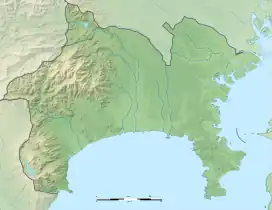Isehara Hachimandai Stone Age Dwelling Site
The Isehara Hachimandai Stone Age Dwelling Site (伊勢原八幡台石器時代住居跡, Isehara Hachimandai sekki-jidai jūkyo ato) is an archaeological site containing the ruins of a Jōmon period settlement located in what is now the Hachimandai neighborhood of the city of Isehara, Kanagawa Prefecture in the southern Kantō region of Japan. The site was designated a National Historic Site of Japan in 1934.[1]
伊勢原八幡台石器時代住居跡 | |
 Isehara Hachimandai Stone Age Dwelling Site  Isehara Hachimandai Stone Age Dwelling Site (Japan) | |
| Location | Isehara, Kanagawa, Japan |
|---|---|
| Region | Kantō region |
| Coordinates | 35°23′20″N 139°18′31″E |
| Type | settlement |
| History | |
| Periods | Jōmon period |
| Site notes | |
| Discovered | 1934 |
| Public access | Yes (no public facilities) |
Overview
The Isehara Hachimandai site is located on a tongue-shaped ridge between the Suzukawa and Shibata Rivers. The foundations of an oval-shaped pit dwelling with an andesite flagstone floor was found in 1933. The pit dwelling measured six meters from north to south and 3.4 meters from east-to-west. These andesite flagstones were from the Nebukawa area of what is now Odawara, and thus had to be transported a considerable distance to this site. In 1934, a second pit dwelling remnant was discovered 150 meters away. It was roughly circular, with a diameter of 8.5 meters, and also had a flagstone floor made of round river stones. At the time, only a few pit dwellings from the middle to late Jōmon period (approximately 3500 years ago) with flagstone floors has been discovered, leading to the protection of these ruins as a National Historic Site. In 1979, new excavations found a third pit dwelling trace adjacent to the second building, and per a survey conducted in 1990, two raised-floor structures, a fourth pit dwelling and 19 graves with pottery sarcophagus were discovered, along with a quantity of Jōmon pottery shards. [2]
The site is located about a 15-minute walk from Isehara Station on the Odakyu Electric Railway Odawara Line. The ruins were backfilled after excavation and only an explanatory placard is at the site.[2]
References
- "伊勢原八幡台石器時代住居跡" (in Japanese). Agency for Cultural Affairs. Retrieved September 20, 2020.
- Isomura, Yukio; Sakai, Hideya (2012). (国指定史跡事典) National Historic Site Encyclopedia. 学生社. ISBN 4311750404.(in Japanese)
External links
- Isehara city official site(in Japanese)